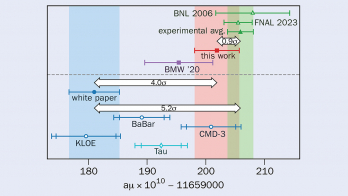The 2008 DESY Theory Workshop focused on the nature of dark matter.
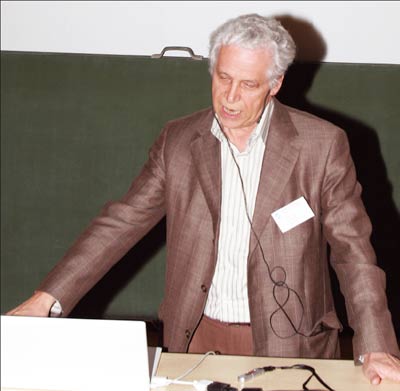
Image credit: DESY Hamburg.
There is overwhelming evidence that the universe contains dark matter made from unknown elementary particles. Astronomers discovered more than 75 years ago that spiral galaxies, such as the Milky Way, spin faster than allowed by the gravity of known kinds of matter. Since then there have been many more observations that point to the existence of this dark matter.
Gravitational lensing, for example, provides a unique probe of the distribution of luminous-plus-dark matter in individual galaxies, in clusters of galaxies and in the large-scale structure of the universe. The deflection of gravitational light depends only on the gravitational field between the emitter and the observer, and it is independent of the nature and state of the matter producing the gravitational field, so it yields by far the most precise determinations of mass in extragalactic astronomy. Gravitational lensing has established that, like spiral galaxies, elliptical galaxies are dominated by dark matter.
Strong evidence for the fact that most of the dark matter has a non-baryonic nature comes from the observed heights of the acoustic peaks in the angular power spectrum of the cosmic microwave background measured by the Wilkinson Microwave Anisotropy Probe, because the peaks are sensitive to the fraction of mass in the baryons. It turns out that only about 4% of the mass of the universe is in baryons, whereas about 20% is in non- baryonic dark matter – a finding that is also in line with inferences from primordial nucleosynthesis.
A host of candidates
This leaves some pressing questions. What is the microscopic nature of this non- baryonic dark matter? Why is its mass fraction today about 20%? How dark is it? How cold is it? How stable is it?
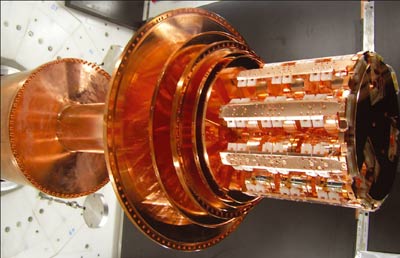
Image credit: CRESST.
Progress in finding the answers to such questions provided the focus for the 2008 DESY b Theory Workshop, which was held on 29 September – 2 October.
Organized by Manuel Drees of Bonn, it sought to combine results from a range of experiments and confront them with theoretical predictions. It is clear that the investigation of the microscopic nature of dark matter has recently entered a decisive phase. Experiments are being carried out around the globe to try to identify traces of the mysterious dark-matter particles. Since the different theoretical candidates appear to have quite distinctive signatures, there are good reasons to expect that from a combination of all of these efforts a common picture will materialize within the next decade.
Theoretical particle physicists have proposed a whole host of candidates for the constituents of non-baryonic dark matter, with fancy names such as axions, axinos, gravitinos, neutralinos and lightest Kaluza–Klein partners. The best-motivated of these occur in extensions of the Standard Model that have been proposed to solve other problems besides the dark-matter puzzle. The axion, for example, arose in extensions that aim to solve the strong CP problem. It later turned out to be a viable dark- matter candidate if its mass is in the micro-electron-volt range. Gravitinos and neutralinos, on the other hand, are the superpartners of the graviton and the neutral bosons, respectively. They arise in supersymmetric extensions of the Standard Model, which aim at a solution of the hierarchy problem and at a grand unification of the strong and electroweak interactions. In fact, neutralinos are natural candidates for dark matter because they have cross-sections of the order of electroweak interactions and their masses are expected to be of the order of the weak scale (i.e. 100 GeV). This leads to the fact that their relic density resulting from freeze-out in the early universe is just right to account for the observed amount of dark matter.
Neutralinos belong to the class of weakly interacting massive particles (WIMPs). Such particles seem to be more or less generic in extensions of the Standard Model at the tera-electron-volt scale, but their stability (or a long enough lifetime) has to be imposed. This is not necessary for super-weakly interacting massive particles (superWIMPs), such as sterile neutrinos, gravitinos, hidden sector gauge bosons (gauginos) and the axino. For example, unstable but long-lived gravitinos in the 5–300 GeV mass range are viable candidates for dark matter and provide a consistent thermal history of the universe, including successful Big Bang nucleosynthesis.
Detecting dark matter
Owing to their relatively large elastic cross-sections with atomic nuclei, WIMPs such as neutralinos are good candidates for direct detection in the laboratory, yielding up to one event per day, per 100 kg of target material. The expected WIMP signatures are nuclear recoils, which should occur uniformly throughout the detector volume at a rate that shows an annual flux modulation by a few per cent. Intriguingly, the DAMA experiment in the Gran Sasso National Laboratory has seen evidence for such an annual modulation.
However, there is some tension with other direct-detection experiments. Theoretical studies have revealed that interpretation in terms of a low-mass (5–50 GeV) WIMP is marginally compatible with the current limits from other experiments. In contrast to DAMA, which looks just for scintillation light, most of the latter exploit at least two observables out of the set (phonons, charge, light) to reconstruct the nuclear recoil-energy.
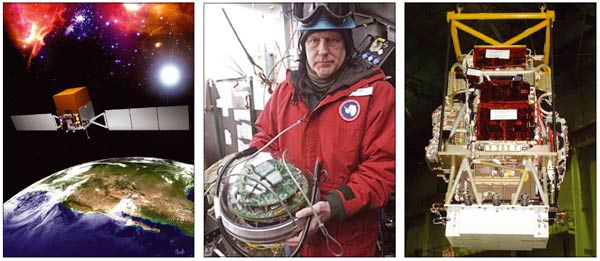
Image credit: General Dynamics C4 Systems, IceCube collaboration, PAMELA Project.
Many different techniques based on cryogenic detectors (e.g. the Cryogenic Dark Matter Search), noble liquids (e.g. the XENON Dark Matter Project) or even bubble chambers, are currently employed to search for WIMPs via direct detection. Detectors with directional sensitivity (e.g. the Directional Recoil Identification From Tracks experiment) may not only have a better signal-to-background discrimination but may also be capable of measuring the local dark-matter, phase-space distribution. In summary, these direct experiments are currently probing some of the theoretically interesting regions for WIMP candidates. The next generation of experiments may enter the era of WIMP (astro) physics.
The axion is another dark-matter candidate for which there are ongoing direct- detection experiments. Both the Axion Dark Matter Experiment (ADMX) in the US and the Cosmic Axion Research with Rydberg Atoms in a Resonant Cavity (CARRACK) experiment in Japan exploit a cooled cavity inside a strong magnetic field to search for the stimulation of a cavity resonance from a dark-matter axion–photon conversion in the microwave frequency region, corresponding to the expected axion mass. While they differ in their detector technology – ADMX uses microwave telescope technology whereas CARRACK employs Rydberg atom technology – both experiments are designed to cover the 1–10 μeV mass range. Indeed, if dark matter consists just of axions then it should soon be found in these experiments. The CERN Axion Solar Telescope, meanwhile, is looking for axions produced in the Sun.
There are also of course possibilities for indirect detection. Dark matter may not be absolutely dark. In fact, in regions where the dark-matter density is high (e.g. in the Earth, in the Sun, near the galactic centre, in external galaxies), neutralinos or other WIMPs may annihilate to visible particle–antiparticle pairs and lead to signatures in gamma-ray, neutrino, positron and antiproton spectra. Moreover, superWIMPs (e.g. gravitinos), may also leave their traces in cosmic-ray spectra if they are not absolutely stable.
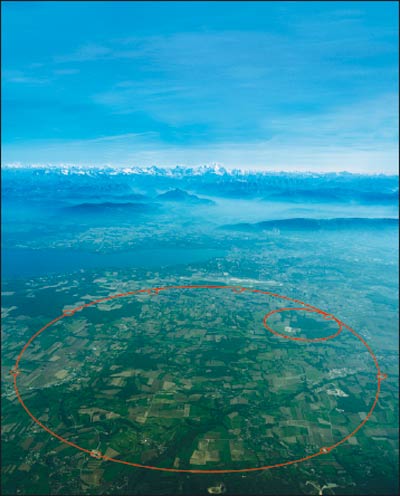
Interestingly, the Payload for Antimatter Matter Exploration and Light-Nuclei Astrophysics (PAMELA) satellite experiment recently observed an unexpected rise in the fraction of positrons at energies of 10–100 GeV, thereby confirming earlier observations by the High Energy Antimatter Telescope balloon experiment. In addition, the Advanced Thin Ionization Chamber balloon experiment has reported a further anomaly in the electron-plus positron flux, which can be interpreted as the continuation of the PAMELA excess to about 800 GeV. The quantification of these excesses is still quite uncertain, not least because of relatively large systematic uncertainties. It is well established that they cannot be explained by the standard mechanism, namely the secondary production of positrons arising from collisions between cosmic-ray protons and the interstellar medium within our galaxy. However, a very conventional astrophysical source for them could be nearby pulsars.
On a more speculative level, these observations have inspired theorists to search for pure particle-physics models that accommodate all results. Generically, interpretations in terms of WIMP annihilation seem to be disfavoured, because they require a huge clumpiness of the Milky Way dark-matter halo, which is at variance with recent numerical simulations of the latter. This constraint is relaxed in superWIMP scenarios, where the positrons may be produced in the decay of dark-matter particles (e.g. gravitinos).
It is clear that one of the keys to understanding the origin of the excess in the positron fraction is the accurate, separate measurement of positron and electron fluxes, which can be done with further PAMELA data and with the Alpha Magnetic Spectrometer satellite experiment. Furthermore, distinguishing different interpretations of the observed excesses requires a multimessenger approach (i.e. to search for signatures in the radio range, synchrotron radiation, neutrinos, antiprotons and gamma rays).
Fortunately the Fermi Gamma-Ray Space Telescope is in orbit and taking data. Together with other cosmic-ray experiments it will probe interesting regions of parameter space in WIMP and superWIMP scenarios of dark matter.
Dark matter at colliders
Clearly, at colliders the existence of a dark-matter candidate can be inferred only indirectly from the apparent missing energy, associated with the dark-matter particles, in the final state of the collision. However, such a measurement can be made with precision and under controlled conditions. To extract the properties, such as the mass, of dark-matter particles, these final-state measurements have to be compared with predictions from theoretical models. In a supersymmetric extension of the Standard Model, for example, with the neutralino as the lightest superpartner, experiments at the LHC would search for signatures from the cascade decay of gluinos and squarks into gluons, quarks, leptons and neutralinos. This would show up as large missing transverse-energy in events with some jets and leptons. The endpoints in kinematic distributions could then be used for the determination of the dark-matter candidate’s mass, which could be compared with the mass determined eventually by measurements of recoil energy in direct-detection experiments.
This complementarity between direct, indirect and collider searches for dark matter is essential. Although collider experiments might identify a dark-matter candidate and precisely measure its properties, they will not be able to distinguish a cosmologically stable particle from one that is long-lived but unstable. In turn, direct detection cannot tell definitely what kind of WIMP has been observed. Moreover, in many superWIMP dark matter scenarios a direct detection is impossible, while detection at the LHC may be feasible. For example, if the lightest superpartner is a gravitino (or hidden gaugino) and the next-to-lightest is a charged lepton, experiments at the LHC may search for the striking signature of a displaced vertex plus an ionizing track.
In many cases, however, precision measurements from a future electron–positron collider seem to be necessary to exploit fully the collider–cosmology–astrophysics synergy. In addition “low-energy photon- collider” experiments – such as the Axion-Like Particle Search at DESY, the GammeV experiment at Fermilab and the Optical Search for QED magnetic birefringence, axions and photo regeneration at CERN, where the interactions of intense laser beams with strong electromagnetic fields are probed – may give viable insight into the existence of very lightweight, axion-like, dark-matter candidates.
In summary, there is evidence for non-baryonic dark matter that is not made of any known elementary particle. We are today in the exploratory stage to figure out its microscopic nature. Many ideas are currently being explored in theories and in experiments, and more will come. Nature has given us a few clues that we need to exploit. The data coming soon from accelerators, and from direct and indirect detection experiments, will be the final arbiter.







